Developed country
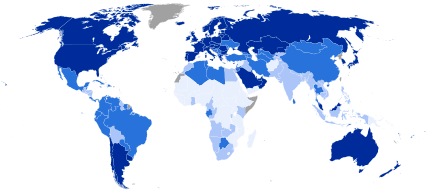
|
1.000–0.800 (very high)
0.700–0.799 (high)
0.555–0.699 (medium) |
0.350–0.554 (low)
Data unavailable |
A developed country, industrialized country, more developed country, or more economically developed country (MEDC), is a sovereign state that has a developed economy and advanced technological infrastructure relative to other less industrialized nations. Most commonly, the criteria for evaluating the degree of economic development are gross domestic product (GDP), gross national product (GNP), the per capita income, level of industrialization, amount of widespread infrastructure and general standard of living.[2] Which criteria are to be used and which countries can be classified as being developed are subjects of debate.
Developed countries have generally post-industrial economies, meaning the service sector provides more wealth than the industrial sector. They are contrasted with developing countries, which are in the process of industrialization or pre-industrial and almost entirely agrarian, some of which might fall into the category of least developed countries. As of 2015, advanced economies comprise 60.8% of global GDP based on nominal values and 42.9% of global GDP based on purchasing-power parity (PPP) according to the International Monetary Fund.[3] In 2017, the ten largest advanced economies by GDP in both nominal and PPP terms were Australia, Canada, France, Germany, Italy, Japan, South Korea, Spain, the United Kingdom, and the United States.[4]
Similar terms
Terms linked to the concept developed country include "advanced country", "industrialized country", "'more developed country" (MDC), "more economically developed country" (MEDC), "Global North country", "first world country", and "post-industrial country". The term industrialized country may be somewhat ambiguous, as industrialization is an ongoing process that is hard to define. The first industrialized country was the United Kingdom, followed by Belgium. Later it spread further to Germany, United States, France and other Western European countries. According to some economists such as Jeffrey Sachs, however, the current divide between the developed and developing world is largely a phenomenon of the 20th century.[5]
Definition and criteria
Economic criteria have tended to dominate discussions. One such criterion is income per capita; countries with high gross domestic product (GDP) per capita would thus be described as developed countries. Another economic criterion is industrialization; countries in which the tertiary and quaternary sectors of industry dominate would thus be described as developed. More recently another measure, the Human Development Index (HDI), which combines an economic measure, national income, with other measures, indices for life expectancy and education has become prominent. This criterion would define developed countries as those with a very high (HDI) rating. The index, however, does not take into account several factors, such as the net wealth per capita or the relative quality of goods in a country. This situation tends to lower the ranking for some of the most advanced countries, such as the G7 members and others.[6][7]
According to the United Nations Statistics Division:
There is no established convention for the designation of "developed" and "developing" countries or areas in the United Nations system.[8]
And it notes that:
The designations "developed" and "developing" are intended for statistical convenience and do not necessarily express a judgement about the stage reached by a particular country or area in the development process.[9]
Human Development Index (HDI)
The UN HDI is a statistical measure that gauges a country's level of human development. While there is a strong correlation between having a high HDI score and a prosperous economy, the UN points out that the HDI accounts for more than income or productivity. Unlike GDP per capita or per capita income, the HDI takes into account how income is turned "into education and health opportunities and therefore into higher levels of human development."
Since 1990, Norway (2001–2006, 2009–2017), Japan (1990–1991 and 1993), Canada (1992 and 1994–2000) and Iceland (2007–2008) have had the highest HDI score.
Many countries listed by IMF or[Note 1] CIA as "advanced", possess an HDI over 0.800, the threshold for "very high" human development. Many countries[Note 2] possessing an HDI of 0.800 and over are also listed by IMF or CIA as "advanced". Thus, many "advanced economies" are characterized by an HDI score of 0.800 or higher. Since April 2016, the IMF classifies Macau as an advanced economy.[10]
The 2018 Human Development Report by the United Nations Development Programme was released on 14 September 2018, and calculates HDI values based on estimates for 2017. Below is the list of the "very high human development" countries:[11]



- The number in parentheses represents the number of ranks the country has climbed (up or down) relative to the ranking in the year of 2016.
|
| |||||||||||||||||||||||||||||||||||||||||||||||||||||||||||||||||||||||||||||||||||||||||||||||||||||||||||||||||||||||||||||||||||||||||||||||||||||||||||||||||||||||||||||||||||||||||||||||||||||||||||||||||||||||||||||||||||||||||||||||||||||||||||||||||||||||||||||||||||||||||||||||||||||||||||||||||||||||||
As a non-UN member, the government of Taiwan calculates its own HDI, which had a value of 0.882 in 2011.[12] Additionally, while the HDI for the Chinese special administrative region of Hong Kong is calculated by the UN, it is not for Macau. The Macanese government calculated the territory's HDI to be 0.868 in 2011. These values place both Taiwan and Macau well within the list of countries with "Very high human development".[13] Furthermore, in 2009 a United Nations project calculated the HDI for all of its members, as well as Taiwan, Macau, and many dependent territories. The HDI values for the countries of San Marino and Monaco, which have not been included in official annual HDI reports, were found to be at 0.961 and 0.956 respectively. This places both countries firmly within the category of countries with "Very high human development" as well. The dependent territories with HDI values equivalent to "Very high human development" were: Jersey, Cayman Islands, Bermuda, Guernsey, Gibraltar, Norfolk Island, Faroe Islands, Isle of Man, British Virgin Islands, Falkland Islands, Aruba, Puerto Rico, Martinique, Greenland, and Guam.[14] Of note, the HDI values in the 2009 report were calculated using the old HDI formula, while HDI values after the year 2010 are calculated with a different formula.
High-income economies
Some institutions have produced lists of developed countries: the UN (list shown above), the CIA,[15] and some providers of stock market indices (the FTSE Group, MSCI, S&P, Dow Jones, STOXX, etc.). The latter is not included here because its association of developed countries with countries with both high incomes and developed markets is not deemed as directly relevant.[Note 3]
However many other institutions have created more general lists referred to when discussing developed countries. For example, the International Monetary Fund (IMF) identifies 39 "advanced economies".[10][16] The OECD's 36 members are known as the "developed countries club"[17][18][19] The World Bank identifies 81 "high income countries".[20]
World Bank high-income economies
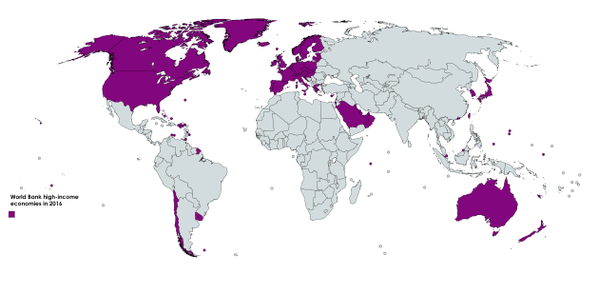
According to the World Bank the following 81 countries (including territories) are classified as "high-income economies".[20] As of 2018, High-income economies are those that had a GNI per capita of $12,056 or more - in 2017.
37 countries and territories wholly or partly in Europe:


.svg.png)











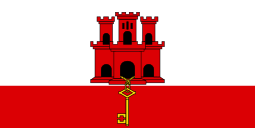






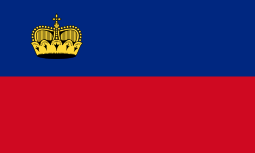
















19 countries and territories wholly or partly in North America:
14 countries and territories wholly or partly in Asia:
7 countries and territories wholly or partly in Oceania:
3 countries wholly or partly in South America:
1 country wholly or partly in Africa:
c Between 1994 and 2009, as part of the ![]()
Development Assistance Committee members
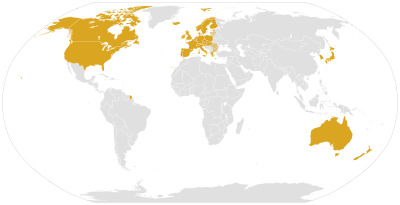
There are 29 OECD member countries and the European Union—in the Development Assistance Committee (DAC),[21] a group of the world's major donor countries that discuss issues surrounding development aid and poverty reduction in developing countries.[22] The following OECD member countries are DAC members:
23 countries wholly or partly in Europe:
2 countries wholly or partly in Asia:
2 countries wholly or partly in North America:
2 countries wholly or partly in Oceania:
IMF advanced economies
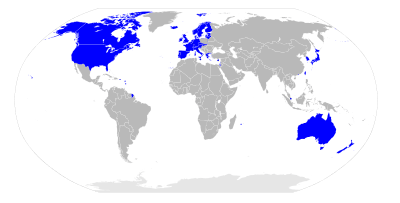
According to the International Monetary Fund, the following 39 economies are classified as "advanced economies":[10]
33 countries and territories wholly or partly in Europe:


.svg.png)






























8 countries and territories in Asia:
4 countries and territories in America:
2 countries in Oceania-Antarctica:
d The CIA has modified an older version of the IMF's list of Advanced Economies, noting that the IMF's Advanced Economies list "would presumably also cover the following nine smaller countries of Andorra, Bermuda, Faroe Islands, Guernsey, Holy See, Jersey, Liechtenstein, Monaco, and San Marino[...]"[15]
Paris Club members
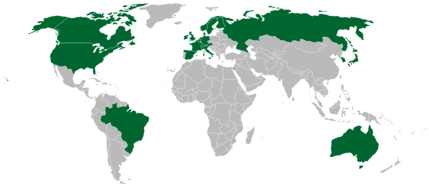
There are 22 permanent members in the Paris Club (French: Club de Paris), a group of officials from major creditor countries whose role is to find coordinated and sustainable solutions to the payment difficulties experienced by debtor countries.
15 countries wholly or partly in Europe:
3 countries wholly or partly in Asia:
3 countries in the Americas:
1 country in Oceania:
See also
Notes
- ↑ The official classification of "advanced economies" is originally made by the International Monetary Fund (IMF). The IMF list doesn't deal with non-IMF members. The Central Intelligence Agency (CIA) intends to follow IMF list but adds few economies which aren't dealt with by IMF due to their not being IMF members. By May 2001, the advanced country list of the CIA Archived 9 April 2008 at the Wayback Machine. was more comprehensive than the original IMF list. However, since May 2001, three additional countries (Cyprus, Malta and Slovenia) have been added to the original IMF list, thus leaving the CIA list not updated.
- ↑ Namely sovereign states, i.e., excluding Macau: In 2003, the government of Macau calculated its HDI as being 0.909 (the UN does not calculate Macau's HDI); In January 2007, the People's Daily Archived 7 December 2008 at the Wayback Machine. reported (from China Modernization Report 2007): "In 2004... Macau... had reached the level of developed countries". The UNCTAD Archived 10 July 2007 at the Wayback Machine. organisation (of the UN), as well as the CIA Archived 9 April 2008 at the Wayback Machine., classify Macau as a "developing" territory. The World Bank classifies Macau as a high income economy (along with developed economies as well as with few developing economies).
- ↑ The Developed Countries Glossary Archived 20 December 2014 at the Wayback Machine. entry reads: "The following countries are classified by FTSE as developed countries: Australia, Austria, Belgium/Luxembourg, Canada, Denmark, Finland, France, Germany, Greece, Hong Kong (People's Republic of China), Ireland, Israel, Italy, Japan, Netherlands, New Zealand, Norway, Portugal, Singapore, South Korea, Spain, Sweden, Switzerland, United Kingdom and the United States."
References
- 1 2 3 4 5 6 7 8 9 "Human Development Report 2018 – "Human Development Indices and Indicators"" (PDF). HDRO (Human Development Report Office) United Nations Development Programme. pp. 22–25. Retrieved 14 September 2018.
- ↑ Developed Economy Definition Archived 22 March 2016 at the Wayback Machine.. Investopedia (16 April 2010). Retrieved 2013-07-12.
- ↑ IMF GDP data (October 2015) Archived 4 March 2016 at the Wayback Machine.
- ↑ "All countries/Advanced economies". www.imf.org. Retrieved 29 June 2018.
- ↑ Sachs, Jeffrey (2005). The End of Poverty. New York, New York: The Penguin Press. ISBN 1-59420-045-9.
- ↑ The Courier. Commission of the European Communities. 1994.
- ↑ "Human development index - Economics Help". Economics Help. Retrieved 2018-09-23.
- ↑ "Millennium Development Indicators: World and regional groupings". United Nations Statistics Division. 2003. Note b. Archived from the original on 10 February 2005. Retrieved 13 May 2017.
- ↑ "Standard Country and Area Codes Classifications (M49): Developed Regions". United Nations Statistics Division. Archived from the original on 11 July 2017. Retrieved 13 May 2017.
- 1 2 3 IMF Advanced Economies List. World Economic Outlook, April 2016, p. 148 Archived 21 April 2016 at the Wayback Machine.
- ↑ "Human Development Report 2018 – "Human Development Indices and Indicators"" (PDF). HDRO (Human Development Report Office) United Nations Development Programme. pp. 32–35. Retrieved 14 September 2018.
- ↑ "2011中華民國人類發展指數 (HDI)" (PDF) (in Chinese). Directorate General of Budget, Accounting and Statistics, Executive Yuan, R.O.C. 2011. Archived (PDF) from the original on 26 December 2011. Retrieved 21 November 2011.
- ↑ Macau in Figures, 2013 Archived 24 October 2013 at the Wayback Machine.
- ↑ Filling Gaps in the Human Development Index Archived 5 March 2016 at the Wayback Machine., United Nations ESCAP, February 2009
- 1 2 CIA (2008). "Appendix B. International Organizations and Groups". World Factbook. Archived from the original on 9 April 2008. Retrieved 10 April 2008.
- ↑ World Economic Outlook Archived 21 April 2016 at the Wayback Machine., International Monetary Fund, September 2011, p. 165.
- ↑ "Archived copy". Archived from the original on 21 February 2009. Retrieved 25 January 2009.
- ↑ Indiana Express Archived 27 January 2010 at the Wayback Machine.
- ↑ Minutes of Forum #26:Global Strategy Series 2 - Japan as It Should Be (Outline) | Economic and Social Research Institute, Cabinet Office, Government of Japan Archived 30 October 2007 at the Wayback Machine.. Esri.go.jp. Retrieved 12 July 2013.
- 1 2 Country and Lending Groups. World Bank. Accessed on 10 July 2018.
- ↑ Peer reviews of DAC members - Organisation for Economic Co-operation and Development Archived 27 May 2013 at the Wayback Machine.. Oecd.org. Retrieved 22 October 2013.
- ↑ DAC website >> "The DAC in Dates" Archived 15 February 2010 at the Wayback Machine., On the DAC's self-description, see the introductory letter. On other events, refer to the relevant section by date.
External links
- IMF (advanced economies)
- The Economist (quality of life survey)
- The World Factbook (developed countries)
- United Nations Statistics Division (definition)
- List of countries, United Nations Statistics Division (developed regions)
- World Bank (high-income economies)